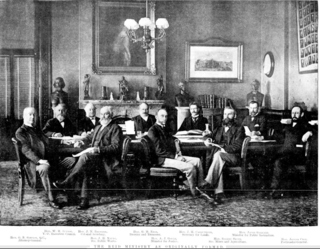Related Research Articles
East Sydney was an electoral district for the Legislative Assembly, in the Australian colony of New South Wales created in 1859 from part of the Electoral district of Sydney City, covering the eastern part of the current Sydney central business district, Woolloomooloo, Potts Point, Elizabeth Bay and Darlinghurst, bordered by George Street to the east, Boundary Street to the west, and, from the creation of South Sydney in 1880, Liverpool Street and Oxford Street, to the south. It elected four members simultaneously, with voters casting four votes and the first four candidates being elected. For the 1894 election, it was replaced by the single-member electorates of Sydney-King, Sydney-Fitzroy and Sydney-Bligh.
Sydney-King was an electoral district of the Legislative Assembly in the Australian state of New South Wales, created in 1894 in central Sydney from part of the electoral district of East Sydney and named after Governor King. It was initially east of George Street, north of Liverpool Street and Oxford Street and west of Riley Street. It also included Lord Howe Island. In 1904, its name was changed to King.

The Reid ministry was the 28th ministry of the Colony of New South Wales, and was led by the 12th Premier, George Reid. The title of Premier was widely used to refer to the Leader of Government, but was not a formal position in the government until 1920. Instead the Premier was appointed to another portfolio, usually Colonial Secretary but on this occasion Reid took the portfolio of Colonial Treasurer until July 1899 and then Attorney General.
The 1901 New South Wales state election was for 125 electoral districts, with each district returning one member. The election was conducted on the basis of a simple majority or first-past-the-post voting system. In this election, in 32 electorates the winning candidate received less than 50% of the votes, while 13 were uncontested. The average number of enrolled voters per electorate was 2,764, ranging from Wentworth (1,706) to Willoughby (4,854).
St George, an electoral district of the Legislative Assembly in the Australian state of New South Wales was created in 1894 and abolished in 1904.
East Sydney, an electoral district of the Legislative Assembly in the Australian state of New South Wales was created in 1859 and abolished in 1894.
Grenfell, an electoral district of the Legislative Assembly in the Australian state of New South Wales was created in 1880 and abolished in 1904.
Singleton, an electoral district of the Legislative Assembly in the Australian state of New South Wales, was created in 1894 and abolished in 1920.
Sydney-Belmore, an electoral district of the Legislative Assembly in the Australian state of New South Wales, was created in 1894 and abolished in 1904.
Sydney-Cook, an electoral district of the Legislative Assembly in the Australian state of New South Wales, was created in 1894 and abolished in 1904.
Sydney-Denison, an electoral district of the Legislative Assembly in the Australian state of New South Wales, was created in 1894 and abolished in 1904.
Sydney-Bligh, an electoral district of the Legislative Assembly in the Australian state of New South Wales, was created in 1894 and abolished in 1904.
Sydney-Fitzroy, an electoral district of the Legislative Assembly in the Australian state of New South Wales, was created in 1894 and abolished in 1904.
Sydney-Flinders, an electoral district of the Legislative Assembly in the Australian state of New South Wales, was created in 1894 and abolished in 1904.
Sydney-Gipps, an electoral district of the Legislative Assembly in the Australian state of New South Wales, was created in 1894 and abolished in 1904.
Sydney-Lang, an electoral district of the Legislative Assembly in the Australian state of New South Wales, was created in 1894 and abolished in 1904.
Sydney-Phillip, an electoral district of the Legislative Assembly in the Australian state of New South Wales, was created in 1894 and abolished in 1904.
Sydney-Pyrmont, an electoral district of the Legislative Assembly in the Australian state of New South Wales, was created in 1894 and abolished in 1904.
A by-election for the seat of Bathurst in the New South Wales Legislative Assembly was held on 14 August 1894 because Sydney Smith had been appointed Secretary for Mines and Agriculture in the Reid ministry. Such ministerial by-elections were usually uncontested and four ministers were re-elected unopposed, James Brunker, Joseph Carruthers, Jacob Garrard (Sherbrooke) and James Young. A poll was required in Bathurst, Hartley, Singleton and Sydney-King however all were comfortably re-elected.
A by-election for the seat of Sydney-King in the New South Wales Legislative Assembly was held on 11 August 1894 because George Reid had been appointed Premier and Colonial Treasurer, forming the Reid ministry. Such ministerial by-elections were usually uncontested and four ministers were re-elected unopposed, James Brunker, Joseph Carruthers, Jacob Garrard (Sherbrooke) and James Young. A poll was required in Bathurst, Hartley, Singleton and Sydney-King however all were comfortably re-elected.
References
- ↑ Green, Antony. "Elections for the District of Sydney-King". New South Wales Election Results 1856-2007. Parliament of New South Wales . Retrieved 30 September 2020.
- ↑ Part 5B alphabetical list of all electorates and Members since 1856 (PDF). NSW Parliamentary Record. Parliament of New South Wales . Retrieved 20 September 2020.
- ↑ "Former Members". Members of Parliament. Parliament of New South Wales . Retrieved 12 December 2019.
- ↑ Green, Antony. "1901 Sydney-King". New South Wales Election Results 1856-2007. Parliament of New South Wales . Retrieved 31 March 2020.
- ↑ Green, Antony. "1898 Sydney-King". New South Wales Election Results 1856-2007. Parliament of New South Wales . Retrieved 8 April 2020.
- ↑ Green, Antony. "1895 Sydney-King". New South Wales Election Results 1856-2007. Parliament of New South Wales . Retrieved 9 April 2020.
- 1 2 Green, Antony. "1894 Sydney-King by-election". New South Wales Election Results 1856-2007. Parliament of New South Wales . Retrieved 25 September 2020.
- 1 2 Green, Antony. "1894 Sydney-King". New South Wales Election Results 1856-2007. Parliament of New South Wales . Retrieved 11 April 2020.